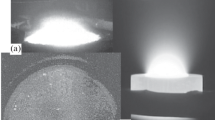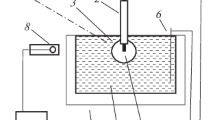Abstract
The results of an experimental study of the effect of an adsorbed gas and surface contaminations of an explosive-emission cathode on the operation of a diode during generation of a high-current electron beam of nanosecond duration are presented. The effect of contaminations was revealed from the change in the rate of expansion of the planar-diode cathode plasma for cathodes of different designs manufactured from different materials and different initial anode-cathode gaps. The plasma velocity was calculated from the experimental perveance of the diode with a resolution of 0.2 ns. Experiments were performed on a ТЭУ-500 pulsed electron accelerator (350–450 kV, 100 ns, and 250 J/pulse) in a mode of matching the diode impedance to the output impedance of the nanosecond generator. It has been found that the velocity of cathode plasma is constant for 70–90 ns after applying voltages to different cathodes at different anode-cathode gaps. The velocities were 2.0 ± 0.5 cm/ μs for carbon cathodes (of different diameters), 3 ± 0.5 cm/μs for multispike tungsten cathodes, and 4.0 ± 0.5 cm/μs for copper (solid or multispike) cathodes. An appreciable dependence of the plasma velocity on the cathode material shows an insignificant influence of the adsorbed gas and cathode surface contaminations on the expansion velocity of the explosive-emission plasma in a planar diode during generation of the electron beam (10–15 ns after a voltage is applied).
Similar content being viewed by others
References
Mesyats, G.A., Impul’snaya energetika i elektronika (Pulsed Power and Electronics), Moscow: Nauka, 2004.
Kotov, Yu.A., Sokovnin, S.Yu., and Balezin, M.E., Zh. Tekh. Fiz., 2003, vol. 73, no. 4, p. 124 [Tech. Phys. (Engl. Transl.), vol. 48, no. 4, p. 503].
Krasik, Ya.E., Dunaevsky, A., Gleizer, J.Z., et al., J. Appl. Phys., 2002, vol. 91, no. 11, p. 9385.
Abdulin, E.N., Bugaev, S.P., Efremov, A.M., et al., Prib. Tekh. Eksp., 1993, no. 5, p. 138.
Remnev, G.E., Furman, E.G., Pushkarev, A.I., et al., Prib. Tekh. Eksp., 2004, no. 3, p. 130.
Remnev, G.E., Pushkarev, A.I., and Furman, E.G., Pis’ma Zh. Tekh. Fiz., 2004, vol. 30, no. 14, p. 63 [Tech. Phys. Lett. (Engl. Transl.), vol. 30, no. 14].
Pushkarev, A.I. and Sazonov, R.V., Prib. Tekh. Eksp., 2007, no. 5, p. 117 [Instr. Exp. Techn. (Engl. Transl.), vol. 50, no. 5, p. 687].
Korolev, Yu.D. and Mesyats, G.A., Avtoemissionnye i vzryvnye protsessy v gazovom razryade (Field-Emission and Explosive Process in Gas Discharge), Novosibirsk: Nauka, 1982.
Karlik, K.V., Ozur, G.E., and Proskurovskii, D.I., Izv. Vyssh. Uchebn. Zaved., Fiz., 2007, no. 9 (Supplement), p. 114.
Pushkarev, A.I., Zh. Tekh. Fiz., 2008, vol. 78, no. 3, p. 78 [Tech. Phys. (Engl. Transl.), vol. 53, no. 3, p. 357].
Erickson, G.F. and Mace, P.N., Rev. Sci. Instrum., 1983, vol. 54, no. 5, p. 586.
Mesyats, G.A., Ektony v vakuumnom razryade: proboi, iskra, duga (Ectons in Vacuum Discharge: Breakdown, Spark, Arc), Moscow: Nauka, 2000.
Pushkarev, A.I. and Sazonov, R.V., Pis’ma Zh. Tekh. Fiz., 2008, vol. 34, no. 7, p. 44 [Tech. Phys. Lett. (Engl. Transl.), vol. 34, no. 7, p. 292].
Mesyats, G.A. and Proskurovskii, D.I., Impulsnyi razryad v vakuume (Pulse Discharge in Vacuum), Novosibirsk: Nauka, 1984.
Shubin, A.F. and Yurike, Ya.Ya., Izv. Vyssh. Uchebn. Zaved., Fiz., 1975, vol. 157, no. 6, p. 134.
Bazhenov, G.P., Ladyzhenskii, O.B., Litvinov, E.A., and Chesnokov, S.M., Zh. Tekh. Fiz., 1977, vol. 47, no. 10, p. 2086 [Sov. Phys. Tech. Phys. (Engl. Transl.), vol. 22, no. 10, p. 1212].
Parker, R.K., Anderson, R.E., and Duncan, C.V., J. Appl. Phys., 1974, vol. 45, p. 2463.
Lebedev, A.N., Fizicheskie protsessy v sil’notochnykh diodakh: Uchebnoe posobie (Physical Processes of High-Current Diodes), Moscow: MIFI, 1984.
Abdullin, E.N. and Bazhenov, G.P., Izv. Vyssh. Uchebn. Zaved., Fiz., 1984, no. 11.
Author information
Authors and Affiliations
Additional information
Original Russian Text © A.I. Pushkarev, R.V. Sazonov, 2008, published in Pribory i Tekhnika Eksperimenta, 2008, No. 6, pp. 103–113.
Rights and permissions
About this article
Cite this article
Pushkarev, A.I., Sazonov, R.V. Studying the effect of adsorbed molecules on the operation of a diode with an explosive-emission cathode. Instrum Exp Tech 51, 875–885 (2008). https://doi.org/10.1134/S0020441208060183
Received:
Accepted:
Published:
Issue Date:
DOI: https://doi.org/10.1134/S0020441208060183




